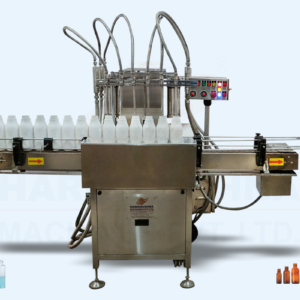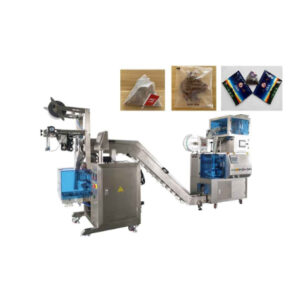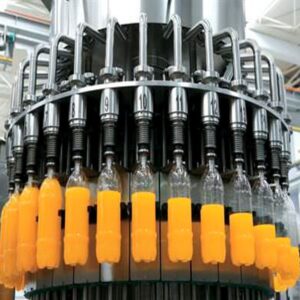Description
| Parameter | Specification |
|---|---|
| Filling Speed | Adjustable, typically up to X liters per minute |
| Filling Volume Range | X ml to X liters (adjustable) |
| Filling Accuracy | ± X% (dependent on product viscosity and setup) |
| Material | Stainless steel construction |
| Power Supply | X volts, X Hz, X phase |
| Control System | PLC-based control system |
| Operator Interface | Touchscreen HMI |
| Nozzle Type | Drip-proof, pneumatic or servo-driven |
| Conveyor System | Variable speed conveyor |
| Cleaning System | Automatic CIP (Clean-In-Place) system |
| Dimensions (L x W x H) | X mm x X mm x X mm |
| Weight | X kg |
| Compliance | CE, FDA (if applicable) |
Lubricants are very essential in various industries as they help the machinery and equipment not to wear out easily. The need for accurate and efficient filling methods has thus increased with the rising demand for lubricants across different sectors. Lubricant filling machines have become critical fixtures in manufacturing plants that ensure containers are filled automatically with diverse forms of lubricants. This paper discusses different types, working processes, applications, tasks, advantages, and future trends of such an item.
Types of Lubricant Filling Machines
Piston Filling Machines: Used extensively in the lubricant industry, piston-filling machines are highly popular among a lot of people. These kinds of machines use pistons to measure and dispense liquids into containers accurately. They can be utilized to fill low-viscosity materials like oils or heavy greases as well.
Gravity Filling Machines: Gravity-filling machines allow the weightless motion of liquid over time helping them fill a container with grease or oil. Low viscosity lubrication can also be done through this method where accuracy is not crucially needed.
Overflow Filling Machines: Overflow type machine on the other hand is used when there’s a possibility of foaming or splashing from liquid being filled into cans/containers. It fills up uniformly by allowing an extra amount of liquid overflow while maintaining the level at which it is being filled.
Net Weight Filling Machines: The net weight filling unit uses weighing scales that capture weights both before and after loading a container with oil grease or any other fluid substance. With these flow meters compensating for container weights, even if viscosities change, correct levels will still be maintained.
Auger Filling Machines: Auger filling machine would come in handy when loading greases or paste-type lubricants into containers like tubes etc., using an auger screw to dispense precise quantities of such substances.
Volumetric Filling Machines: A volumetric filling device measures out a certain amount according to the volume of lubricant. It is also suitable for filling containers with equal volume.
Working Process of Lubricant Filling Machines
The way lubricant filling machines work will depend on the type of machine and specific application requirements. However typically, these are some of the steps involved in carrying out the process:
Container Placement: The empty container is positioned on the machine’s conveyor or filling platform.
Filling Preparation: Adjust the apparatus based on factors such as fill amount, lubricant thickness, and vessel category.
Filling Operation: To fill up its contents, lubricants are poured into containers using various approaches like the piston method, gravity, or overflow.
Measurement and Control: In case there is a measurement system in place, this helps to ensure accurate fill volumes are maintained during operation.
Container Removal: When filled they are taken away from the machine that fills them before being subjected to other activities like capping or labeling depending on each one’s nature when packaged.
Cleaning and Maintenance: The machine should be kept clean while all worn-out components should be replaced with new ones thus it remains efficient throughout.
Applications of Lubricant Filling Machines
Lubricant filling machines can be used in various industries where one needs to apply oils. Some common examples include:
Automotive Industry: Motor oil, transmission fluid, and other automotive maintenance fluids can be poured into containers using lubrication filling machines.
Industrial Manufacturing: Industrial manufacturing facilities use lubricating oil-filling equipment to put grease into machinery parts, equipment, and assembly lines.
Aerospace Industry: For the aerospace industry, ensuring aircraft components work smoothly is a very important role played by lubricants. Aviation lubricants and hydraulic fluids are filled into containers using lubricant-filling machines.
Marine Industry: Marine engines and equipment require lubricants for them to be able to withstand harsh marine environments. Ships and offshore installations are filled with marine-grade lubricants through the use of lubricant-filling machines.
Consumer Products: Other uses of these materials include bicycles, power tools, and household appliances, among many others. These types of fillings are done using machinery such as Lubricant Filling Machines.
Functions of Lubricant Filling Machines
Lubricant filling machines play several vital roles in manufacturing and packaging processes:
Precision Filling: Accuracy and compliance with the required standard for quality can only be attained by employing Lubricant Filling Machines which ensure that products are injected into their respective containers well to avoid any wastage.
Automation: They increase efficiency in industries due to reduced labor costs and improve productivity in manufacturing plants because they perform various functions automatically when it comes to bottle filling.
Versatility: This feature allows different types of them to serve different viscosity levels and container sizes hence meeting diverse requirements for specific tasks on a wide range of applications.
Hygiene and Safety: The safety of operators who use such devices is guaranteed because they were made to meet hygiene standards thus providing assurance of quality products delivered always.
Integration with Packaging Lines: Lubricant filling machines also easily integrate with other packaging equipment like capping machines or labeling machines as well as conveyor systems for a complete packaging solution.
Benefits of Lubricant Filling Machines
The introduction/adoption/installation/launching/use/application (choose one word) solely depends on the manufacturer’s or business person’s preference; however, the benefits obtained from this decision are numerous;
Improved Efficiency: In summary, automated filling processes reduce production time leading to improved overall performance in the manufacturing industry.
Enhanced Accuracy: Henceforth, lubricant filling machines have precision filling mechanisms that enable them to dispense the right quantities of this substance minimizing any excess products or discrepancies in the level of fill.
Cost Savings: The application of these machines therefore helps to save costs on lost product, labor as well and time for industries hence a good business decision.
Quality Assurance: The consistency of filled volumes and conformity to quality standards are responsible for the integrity and reliability of those products thereby enhancing customer satisfaction and brand reputation.
Flexibility and Scalability: Companies who produce such filling machines can scale them up or reconfigure them accordingly so that they can increase production capacity whenever there is a demand surge at their plants or expand their product lines for example.
Future Trends in Lubricant Filling Machines
In the future, lubricant filling machines shall encompass several improvements and notable advancements due to technological progress;
Industry 4.0 Integration: As internet technology continues to improve rapidly, integration with artificial intelligence (AI), and machine learning (ML) will also become the norm in areas such as predictive maintenance, remote monitoring, and real-time optimization of all lubricant filling processes including that which occurs here.
Enhanced Sustainability: Future lubricant filling machines will promote eco-friendly operations by being energy-efficient, using recyclable materials only, and minimizing the consumption of resources like water or oil-based greases.
Customization and Personalization: Modern lubricating agent incorporation methods involve new techniques that are more flexible when it comes to customizing specifications in terms of container sizes volume levels as well as packaging formats thus enabling businesses to focus on specific consumer segments effectively.
Improved User Interfaces: Therefore, these devices should have friendly user interfaces that make it easier for people working with them on a daily routine to be able to operate easily without training requirements since it enhances their effectiveness.
Integration with Robotics: Incorporating robotic arms into the manufacturing process chain especially when dealing with robots involved in labeling, capping, container handling, etc., will enable the device to be easily integrated with many of these machines.
Frequently Asked Questions
1. What types of lubricant filling machines are available?
Piston fillers, gravity fillers overflow fillers net weight filling machines auger fillers volumetric fillers for lube oils are some types of Lubricant filling machines that exist.
2. What industries utilize lubricant filling machines?
The automotive industry, Industrial manufacturing sector, Aerospace equipment, Marine vessels, and Consumer product makers depend on a variety of lubricating oil packaging equipment to achieve their respective ends.
3. How do lubricant filling machines work?
The working process of the lube oil bottle refill machine includes container placement; preparation for performing the refilling task; actual refilling procedure itself; measurement and control; taking away containers from the machine after successful completion of the task; and cleaning/maintenance activities concerned with it.
4. What are the benefits of using lubricant-filling machines?
Improved efficiency Cost savings Enhance accuracy Quality assurance Flexibility/scalability manufacturing operations.
5. What applications do lubricant filling machines serve?
Lubricating equipment is utilized during automotive maintenance Industrial manufacturing Aerospace lubes Marine operations Consumer product packaging.
6. How do lubricant filling machines contribute to sustainability?
Further development of lube oil filling machines in the future includes sustainable energy usage while they are in operation, recyclable materials, and less resource consumption.
7. What are some major cities and countries where lubricant-filling machines are utilized?
Major cities such as New York, Tokyo, London, and Sydney are amongst the leading users of industrial lube oil equipment in the world.
8. What advancements are expected in lubricant filling machines in the future?
These include: Industry 4.0 integration Sustainability improvement Customization/personalization Better user interfaces Robotics integration
9. How do lubricant filling machines ensure precision in filling operations?
While dispensing oils into containers, lubricating oil packaging machines have been designed to utilize various accurate measurement systems such as pistons, gravity, or volumetric methods to accurately dispense oils into containers.
10. What role do lubricant filling machines play in maintaining machinery and equipment?
Through the application of the right quantities of lubricants on machinery parts, these devices ensure that friction is reduced as well as preventing tear and wear thus enhancing their durability and operational efficiency.





